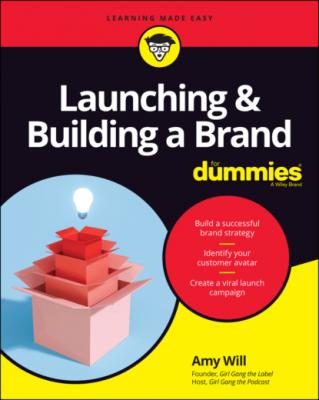Launching & Building a Brand For Dummies. Amy Will
Чтение книги онлайн.
Читать онлайн книгу Launching & Building a Brand For Dummies - Amy Will страница 14
 the domain in your email address (such as
the domain in your email address (such as [email protected]) to reinforce your brand in every outgoing email message.
(Optional) Create a branded app (or hire an app developer to do the work for you) that further reinforces your brand while making it easy for customers or clients to place orders and stay connected.
See Chapter 7 for details.
Step 7: Forming strategic partnerships
One of the most powerful ways to promote your brand is to form mutually beneficial partnerships with other brands, sort of like hitching your wagon to a star. If your brand is built around retail, getting your products into popular retail chains is one approach. I was able to persuade Nordstrom to carry my Girl Gang the Label fashion line, which was mutually beneficial. The partnership generated sales and revenue for both parties, increased my brand’s profile, and helped Nordstrom position itself as a hip place to shop.
Step 8: Launching your brand
After building your brand, when you have all the pieces in place, you’re ready to launch it. This step involves scheduling the launch, preparing incentives to generate interest, getting press coverage, and making it easy for users to share your content with everyone they know. See Chapter 10 for guidance on executing a successful launch campaign.
Step 9: Promoting your brand
Promoting your brand involves everything you do during and after your launch to extend your brand’s reach and strengthen brand awareness. It typically involves the following activities:
Content marketing — sharing content that subtly promotes your brand without explicitly doing so (see Chapter 8)
In-person experiences, such as events, pop-up stores, retail locations, and conferences (see Chapter 11)
Podcasting — sharing audio presentations and interviews (see Chapter 12)
Social media marketing (see Chapter 13)
Email marketing (see Chapter 14)
Advertising (see Chapter 15)
Step 10: Caring for and protecting your brand
Branding is a lifelong journey — the life of the brand, that is. As long as the brand is in existence, you need to care for it and protect it, which involves the following activities:
Auditing and scaling your brand to increase its reach while expanding brand awareness
Building on customer loyalty and longevity to transform customers into brand advocates
Protecting your brand from competitors and anyone who may try to steal your intellectual property
Chapter 2
Creating and Financing Your Brand
IN THIS CHAPTER
Branding assumes that you have something to brand — a business, a product, a service, or even yourself. You need something you can stick a label or hang a sign on. If you already have that something clear in your mind, you can safely skip this chapter. If your vision is still a little fuzzy around the edges, or if you could use some guidance on coming up with an idea or getting your idea off the ground, you’ve come to the right place.
In this chapter, I introduce you to the various entities you can brand, and I highlight some differences in the branding process for each type. I show you how to find or choose a niche that improves your chances of success. I explain how to register your business/brand and choose the right legal structure for it. Last but not least, I reveal a few ways to get other people to help finance what may be a risky venture.
Deciding What You’re Going to Brand
You can create a brand for just about anything — products and services, businesses and corporations, performers and groups (think Cirque du Soleil), celebrities and influencers, government entities (including nations) and nongovernment organizations (NGOs), not-for-profit organizations, even places (I ♥ NY, for example). The four most commonly branded things are businesses, products, services, and individuals (personal branding).
Sometimes, the lines dividing these different brand types get a little blurry. When you are the business, for example, do you create a business brand or a personal brand? In this section, I introduce you to the four most common brand types so you can figure out what you’re branding and how that decision will affect your approach to branding.